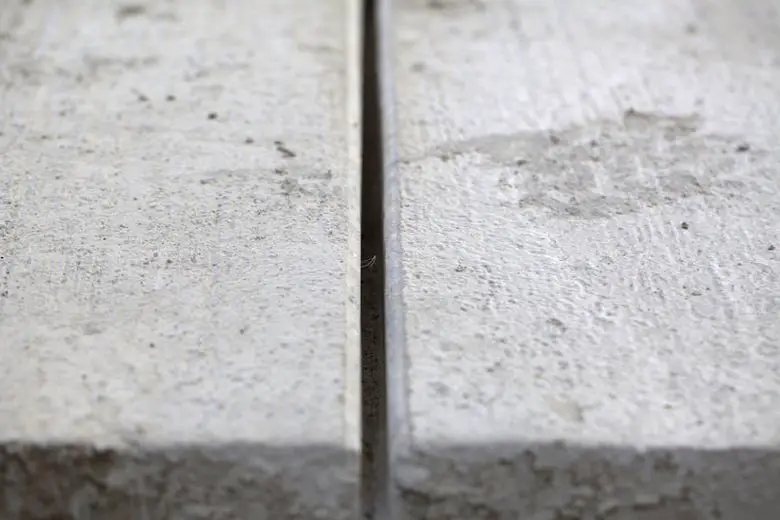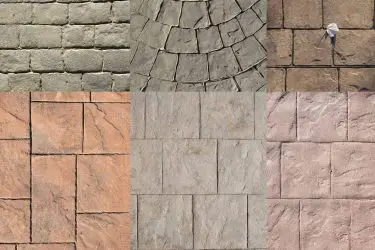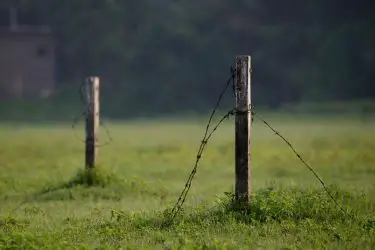To caulk or not to caulk? When it comes to concrete control joints, there is an ongoing debate regarding whether it is necessary to seal control joints in concrete. Some experts advise it, while others suggest it’s not worth the effort.
Concrete joints should be caulked in most cases. Caulking is often necessary to prevent moisture from reaching the base of the concrete slab. It also helps prevent dust, weeds, bacteria, and pollutants from posing health risks, compromising aesthetics, and causing structural damage.
If you’re asking yourself whether you should caulk the control joints found on the concrete in your driveway or pavement, this article is for you. In the following sections, I’ll explain what caulking consists of, why it is often necessary, and how you should execute the process to make sure that you seal the joints properly.

Table of Contents
Why It Can Be Necessary To Caulk Concrete Control Joints
Control joints are gaps that are left in concrete structures to control the cracking of the material as it contracts and expands due to changes in temperature and moisture. For example, control joints relieve the stress caused by the shrinkage that inevitably happens when concrete cures.
Because they are gaps, by definition, control joints are very likely to gather different types of debris and particles, not to mention moisture and even grass and weeds.
These can turn into serious issues if they are not addressed.
Water or moisture is probably the number one enemy of concrete. If you allow moisture to get into the control joints, there’s a chance it’ll reach further into the base of the concrete layer and affect the stability and longevity of the slabs or even cause a vertical shift of the structure.
Debris, dust, and dirt can become an aesthetic issue at best and a health hazard at worst if allowed to collect in the control joints. The appearance of your driveway or pavement would be affected, as dirty and unkempt is probably not the look you want for the front of your house.
More importantly, the combination of particles and water can encourage certain bacteria to thrive. That can pose health hazards if food is being handled or there are people with health problems nearby.
Caulking the control joints would help avoid these problems.
Finally, grass and weeds can grow inside the control joints if they are not sealed, making your driveway or pavement look untidy and ugly.
Even if you’re not concerned about aesthetics, there’s a practical reason why you shouldn’t allow any growth in the control joints: the roots of these plants may dig into the concrete and ruin it.
Related article: 9 Ways to Permanently Stop Weeds Growing through Concrete
Difference Between Joint Sealing (Caulking) and Filling
Before I walk you through how to caulk control joints in concrete, I should clarify the difference between joint filling and sealing.
While they may seem as if they’re the same thing, there are some fundamental differences between the two in terms of their purpose, processes, and the materials used.
Joint sealing or caulking is what you should do when you want to isolate or seal the control joint to protect it from moisture and other threats that can compromise the condition of the concrete. This is usually done for exterior joints, and the sealer used is flexible and relatively soft.
On the other hand, a joint filling is usually done for interior joints in an attempt to protect the edges from chipping. The material used for joint filling is typically hard and stiff, as it needs to provide ideal protection for the edges.
How To Caulk Concrete Control Joints
Before diving into more details, it’s important to point out that being patient, choosing the right sealer, and using high-quality tools are essential if you want to caulk control joints well.
See a video guide further down this post!
The first thing you’ll need to do is ensure you have all the necessary materials and tools. These include:
- Sealing material
- A good caulk gun
- Silica sand or play sand
- Cleaning tools.
Don’t underestimate the importance of the quality you choose for the materials and tools you’re working with; it’ll make a huge difference in the end result.
Speaking of materials, make sure you’re using a polyurethane caulk to seal the concrete control joints and that it’s not a self-leveling caulk. Another popular material that is used to caulk concrete control joints is silicone. Silicone is quite flexible and resistant. More importantly, it lasts longer than polyurethane because it doesn’t degrade as quickly.
Here are a few other tips you’ll need to keep in mind when caulking concrete control joints:
- Before the actual caulking, use an angle grinder to thoroughly clean the control joints so that the gap is uniform. After clearing away the debris caused by the angle grinder, apply masking tape to both sides of the joint in straight lines, just below the edge of the gap.
- Once you’re done applying the tape, apply the caulk patiently. I highly recommend using a sausage system to control the size of the tip of the gun and avoid waste.
- Try to make sure that you’re not under or overfilling the joint. The gun should be held at a 45-degree angle, sliding sideways. The direction of the work doesn’t matter; work in whichever direction you feel more comfortable.
- It helps to keep in mind the way you want the finished product to look like. Additionally, make sure that the sealer is reaching all the way down to the bottom of the crack.
- When you’re done applying the caulk, dry-tool the bead according to the instructions on the caulk tube. You can also use some sort of liquid cleaner, although there’s a chance that the caulk might bubble. After cleaning, remove the masking tape carefully and then clean the sides with cleaning solutions.
Here’s an instructional video that can help you better understand the process.
To Caulk or Not To Caulk
I just presented some hard-to-ignore arguments for why it’s often a good idea to caulk the control joints in concrete. Namely, it helps avoid damage to the concrete, untidiness, and potential health hazards.
However, there’s a wide range of opinions out there when it comes to this surprisingly polarizing subject.
The main counter-argument is that the process of caulking concrete control joints might not be very cost-effective. Some experts think that maintaining the seals, especially in certain climatic conditions, is not worth the time and effort because it doesn’t affect the concrete’s stability that much.
The bottom line?
There is no “right” or “wrong” as far as deciding whether to caulk goes. The ideal solution for you depends on your circumstances.
It might be a good idea to be proactive and caulk the concrete control joints to avoid some of the issues I’ve mentioned above. On the other hand, it may be reasonable to consider leaving any unsealed control joints that are not subject to many of the conditions that I mentioned above.
Conclusion
There might be differing opinions on whether it’s a good idea to caulk concrete control joints or not. In general, it’s a recommended process that can protect the concrete. Caulking itself is a straightforward procedure, as long as you use good-quality materials and tools.
I would advise caulking concrete control joints to protect the concrete from any possible damages, and at the same time to make sure it looks aesthetically pleasing and clean. If there are control joints at places that aren’t exposed to weather conditions or pollutants, it may be reasonable to skip caulking.



